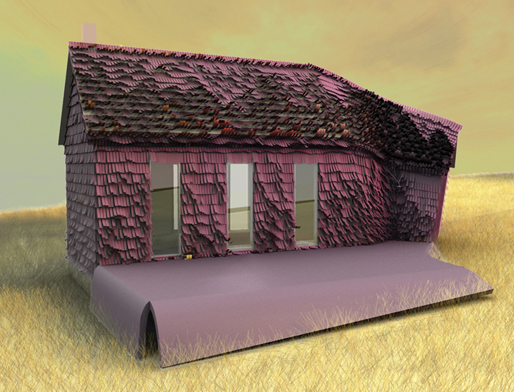
Sep '08 - Sep '11
Our research studio prof Jason Payne invited us to the final review of his studio at “crosstown rival” SCI-Arc last week, and as the discussion turned out to be pretty interesting I thought I’d relate some of it here.
The studio used animal hides as both site and as driver of form through material qualities. Jason ran pretty much the same studio at Knowlton/Ohio State; as fellow schoolblogger Greg described. The work itself included an animal hide, I believe mostly from cows, somehow altered by operations including stiffening with resin, or with formworks of metal, wood, or plaster. Small wax models were used to test operations on the hides, and surprisingly for a Jason studio, very few drawings were presented, mostly only one per group. The work was very interesting when compared to what we’re doing for Jason at UCLA; the slightly viscerally disgusting hides at SCI-Arc made our work at UCLA look anemic, stark and cerebral. As Jason pointed out though, the reviews for both bodies of work elicited interestingly similar, and similarly intense, reactions from their respective juries. More about our continuing work at UCLA in a later post though.
wax study models
The jury at SCI-Arc included two UCLA theory professors, Sylvia Lavin and Michael Osman, as well as SCI-Arc profs Hernan Diaz-Alonso, Marcelo Spina (Patterns), and Eric Kahn.
Hernan simultaneously texting and iPhotoing - reminds me of myself
Sylvia of course dominated the discussion, and was in rare form, even for her. The discussion began fairly well-mannered, with Jason describing the aims of the studio, which intended to alienate the hides from their sociocultural referents and treat them as if an alien (i.e. David Bowie as the Man Who Fell To Earth) found them and tried to reconstitute their form from the hides’ intrinsic material qualities. But soon enough Sylvia called out the “elephant in the room” - that the hides were “grisly artifacts of actual living animals”, that the cow has not yet been excised from the fur. She said she didn’t buy the fact that these hides are separated from architecture in the same way building can’t be separated from architecture - “architecture is the albatross around these projects” - it must either be worked with from the beginning or it will haunt the projects. Diller & Scofidio’s “Bad Press: Dissident Ironing”, a project where they ‘mis-ironed’ white mens’ shirts, was brought up as an analog to the formfinding work with furs, except that D&S acknowledged the shirt’s referent to hygiene and used incorrect creases to consciously pervert it. Sylvia then pronounced that Jason often works within a kind of “neonaturalistic primitivism” (which I think is a great phrase), which can sometimes verge onto the “edge of scary unibomber territory”, and that in the work of the SCI-Arc students, that edge is very clearly visible.
I was into this plaster detail and the resin-reinforced vertical loadbearing hide-columns
Then she spotted a brand and some blood left on a hide and asked why there weren’t more such identifying marks on the hides but acknowledged that that wouldn’t be pure formfinding, as the studio was set up to be. In regard to this continuing emphasis on the formal, Silvia said something like ‘you know Jason, you put yourself out there as such a wacky guy, but I think really you’re a fundamentalist’, to which he acknowledged the Unibomber by saying ‘yeah, maybe I’ll go to my log cabin and write a manifesto’. When a student used animal metaphors to describe the formal operations in their project, Sylvia really went to town, warning “beware the animal” - by using a discourse of the animalistic and associating it with the material of the hide because it was born as an animal, she asserted that it was ‘dangerous ground’ as a form of essentialism, that millions of people are slaughtered due to what other people believe to be essential to their bodies. Sylvia later stated that “political speak in architecture is the fucking worst; run away!” and that one of the group’s delicate use of contour lines to describe their topological modifications to the hide was as much of a cop-out as putting victims of mass rape in a pink room because it supposedly makes them feel better - in turn making us feel better. Tough jury!
why does that girl look so much like Maybe from Arrested Development?
The other jurors all also had good points, I just didn’t write many of them down since Sylvia is just so much better at sound bites. Michael Osman had some interesting comments linking the work to a history of surrealism (Oppenheim’s fur cup only the most obvious), and Eric Kahn said the best of the work was more about finding “moments of the feral in the digital” - in a sense creating a feedback loop between the material and the digital model. He used as an example Jason’s Raspberry Fields house, and what it might be like if the wildness of the shingles was the result of a script that attempted to find a wild/feral moment of growth in the otherwise well-mannered digital model. 
Jason's Raspberry Fields
In response to the feral/digital point, Osman brought up Michael Meredith’s (MOS) ‘wet dog’ installation for the PS1 Young Architect’s Program (the entry was actually called “afterparty”), and how Meredith has stated that such work produces a politics; Jason’s studios on hides are doing the same thing.
my 'atmospheric' pic of Meredith's wet dog
Anyway, cheers SCI-Arc for providing an interesting review; I hope you didn’t mind UCLA crashing the party for a bit.
No Comments
Block this user
Are you sure you want to block this user and hide all related comments throughout the site?
Archinect
This is your first comment on Archinect. Your comment will be visible once approved.